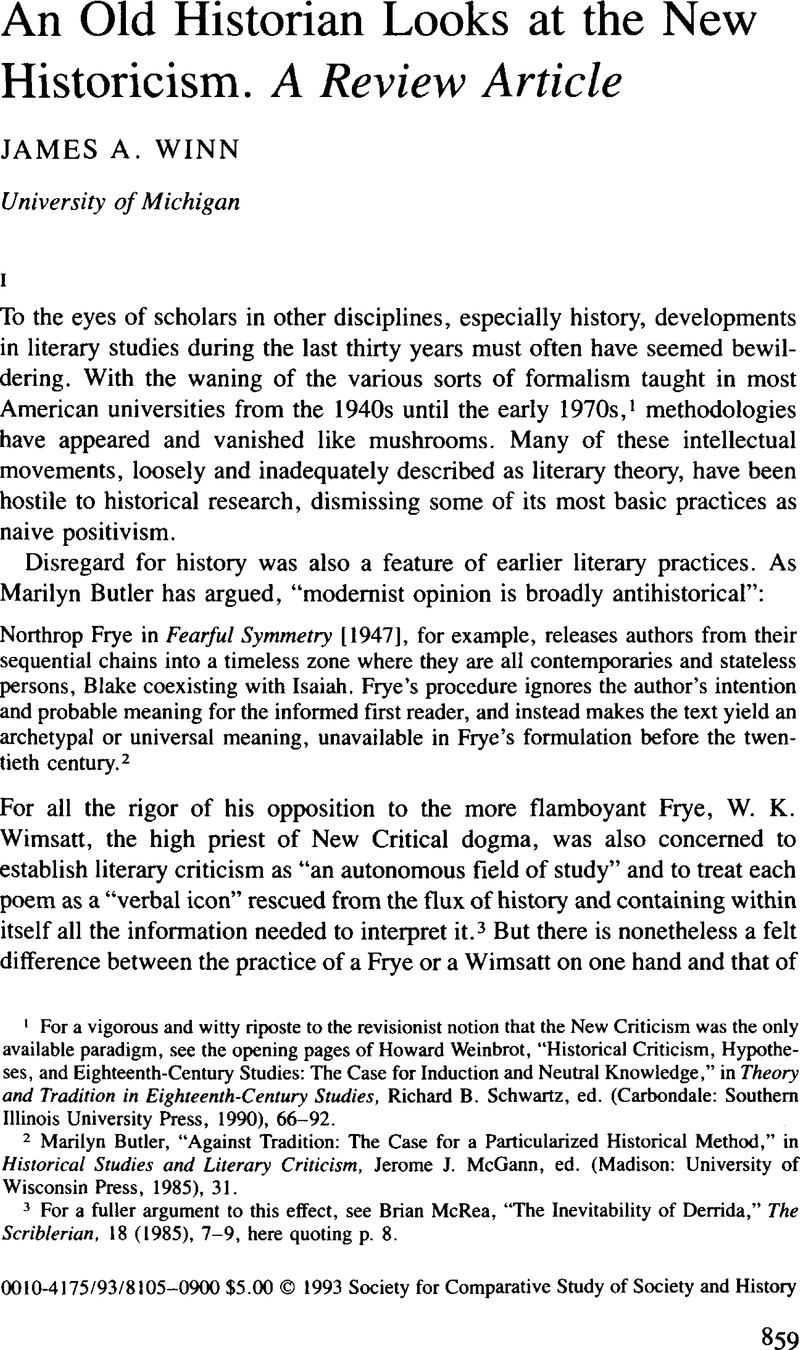Article contents
An Old Historian Looks at the New Historicism. A Review Article
Published online by Cambridge University Press: 03 June 2009
Abstract

- Type
- CSSH Discussion
- Information
- Copyright
- Copyright © Society for the Comparative Study of Society and History 1993
References
1 For a vigorous and witty riposte to the revisionist notion that the New Criticism was the only available paradigm, see the opening pages of Weinbrot, Howard, “Historical Criticism, Hypotheses, and Eighteenth-Century Studies: The Case for Induction and Neutral Knowledge,” in Theory and Tradition in Eighteenth-Century Studies, Schwartz, Richard B., ed. (Carbondale: Southern Illinois University Press, 1990), 66–92Google Scholar.
2 Butler, Marilyn, “Against Tradition: The Case for a Particularized Historical Method,” in Historical Studies and Literary Criticism, McGann, Jerome J., ed. (Madison: University of Wisconsin Press, 1985), 31Google Scholar.
3 For a fuller argument to this effect, see McRea, Brian, “The Inevitability of Derrida,” The Scriblerian, 18 (1985), 7–9, here quoting p. 8Google Scholar.
4 Anatomy of Criticism (Princeton: Princeton University Press, 1957), 34Google Scholar.
5 Butler, “Against Tradition.”
6 Private communication.
7 I quote Jeffrey Barnouw's summary of de Man's position, in his review of Allegories of Reading, ECCB, n.s. 6 (1980), 339Google Scholar.
8 For a fuller account of my own position with respect to deconstruction, see “Some Doubts about Deconstruction,” The Scriblerian, 17(1985), 117–21Google Scholar.
9 For a spirited argument to this effect, see Hume, Robert D., “Texts Within Contexts: Notes Toward a Historical Method,” Philological Quarterly, 71 (Winter, 1992), 69–100Google Scholar.
10 See The Development of English Drama in the Late Seventeenth Century (Oxford: Clarendon, 1976Google Scholar); The Rakish Stage (Carbondale: Southern Illinois University Press, 1983)Google ScholarPubMed; Henry Fielding and the London Theatre, 1728–1737 (Oxford: Clarendon, 1988Google Scholar); and hundreds of specialized articles.
11 “The New Historicism in Renaissance Studies,” English Literary Renaissance, 16 (1986), 13–43, here quoting page 19CrossRefGoogle Scholar.
12 Cf. Simpson, David, “Literary Criticism and the Return to ‘History,’” Critical Inquiry, 14 (Summer, 1988), 721–47, here quoting page 724CrossRefGoogle Scholar.
13 My quotations follow the final version of this much-revised essay, which appears in Shakespearean Negotiations: The Circulation of Social Energy in Renaissance England (Berkeley: University of California Press, 1988), 94–128Google Scholar.
14 Nor is this the only place in the essay where Greenblatt invokes cultures quite unlike Elizabethan England; a later passage discusses “an illuminating study of possession among the Ethiopians of Gondar” (p. 111).
15 The quoted phrases are Howard, Jean's, “The New Historicism,” 23, 20Google Scholar.
16 Cf. Oxford English Dictionary, s.v. “spate”: “A flood or inundation; esp. a sudden flood or rising in a river or stream caused by heavy rains or melting snow.”
17 Louis Montrose acknowledges as much in a recent essay: “Geertz's work offered to literary critics and cultural historians not so much a powerful theory of culture as an exemplary and eminently literary method for narrating culture in action, culture as lived in the performances and narratives of individual and collective human actors.” See “New Historicisms,” in Redrawing the Boundaries of Literary Study, Gunn, Giles and Greenblatt, Stephen, eds. (New York: MLA, 1992), 392–418Google Scholar, here quoting p. 399. My thanks to Professor Montrose for permission to quote him and to Steven Mullaney for calling my attention to this passage.
18 For a telling critique of the anecdotal method, see Ross, Marlon B., “Contingent Predilections: The Newest Historicisms and the Question of Method,” Centennial Review, 34 (1990), 485–538, especially 487–92Google Scholar.
19 “The Power of Formalism: The New Historicism,” ELH, 56 (Winter, 1989), 721–71, here quoting pp. 721–2CrossRefGoogle Scholar.
20 See Greenblatt, , Renaissance Self-Fashioning: From Moore to Shakespeare (Chicago: University of Chicago Press, 1980)Google Scholar.
21 The Garden and the City (Toronto: University of Toronto Press, 1969), vii–viiiGoogle Scholar.
22 “A New History of the Enlightenment,” Eighteenth-Century Life, 16 (1992), 1–20, here quoting p. 4Google Scholar.
23 Hutton, Ronald, Charles the Second, King of England, Scotland, and Ireland (Oxford:Clarendon, 1989CrossRefGoogle Scholar); Gregg, Edward, Queen Anne (London: Routledge and Kegan Paul, 1980Google Scholar).
24 “Discursive Forums, Cultural Practices: History and Anthropology in Literary Studies,” in The Historic Turn in the Human Sciences: Essays on Transformations in the Disciplines, McDonald, Terrence J., ed. (Ann Arbor: University of Michigan Press, 1992Google Scholar).
25 Poovey, 's first book, The Proper Lady and the Woman Writer: Ideology as Style in the Works of Mary Wollstonecraft, Mary Shelley, and Jane Austen (Chicago: University of Chicago Press, 1984Google Scholar), grounds its readings of those authors in an exhaustive survey of eighteenth-century conduct books. McKeon, 's first book, Politics and Poetry in Restoration England: The Case of Dryden's “Annus Mirabilis” (Cambridge: Harvard University Press, 1975) offers a primary bibliography running of some thirty pages listing manuscripts and obscure printed works on the events of the later 1660sCrossRefGoogle Scholar.
- 1
- Cited by


